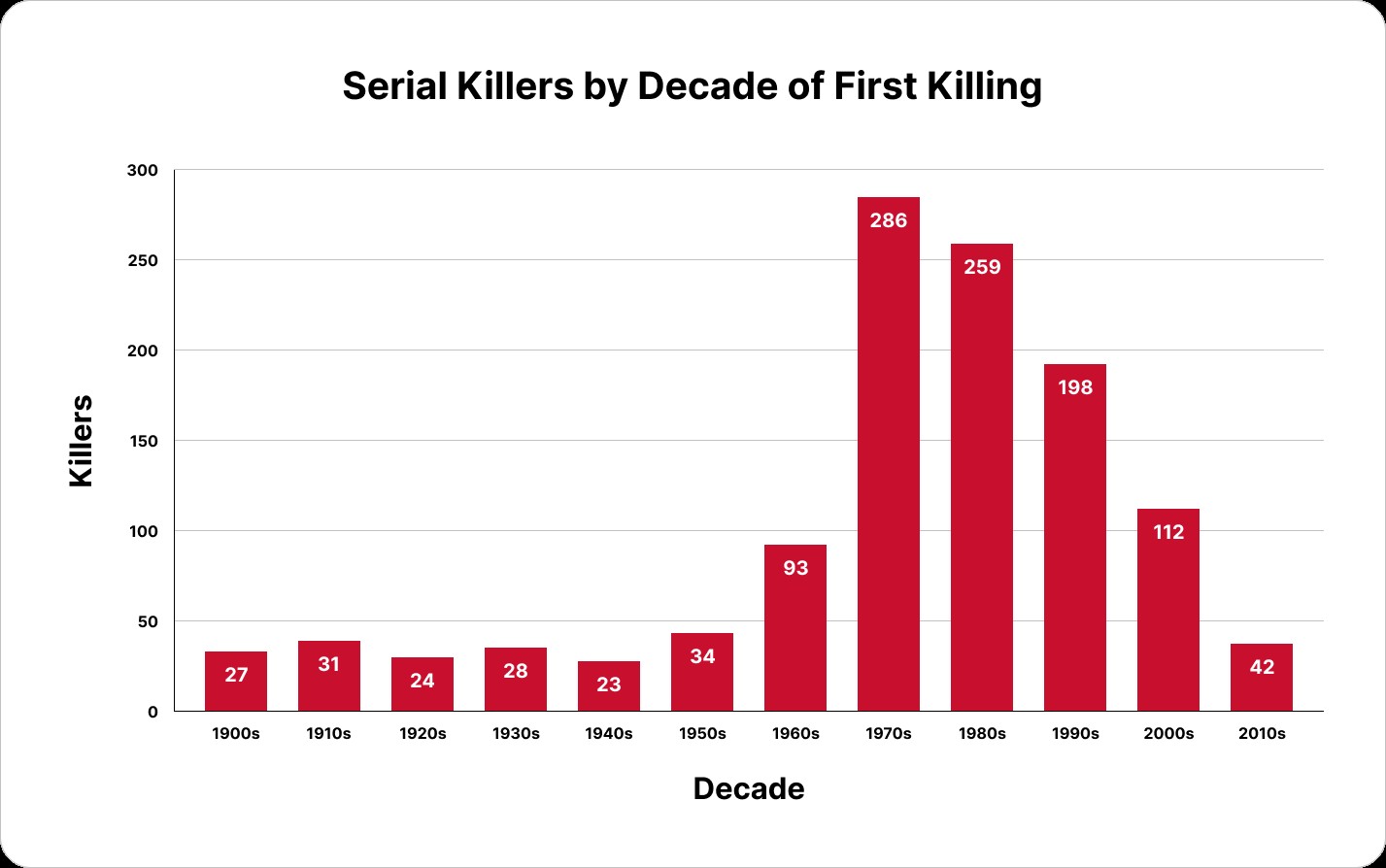Why Were There So Many Serial Killers In The 70s? This question explores a dark chapter in American history, examining the confluence of factors that led to a surge in serial killer activity. At WHY.EDU.VN, we delve into these complex issues to provide clarity and understanding. Discover insights into potential connections to societal shifts and explore crime statistics.
1. The Prevalence of Serial Killers in the 1970s
The 1970s are often seen as the peak of serial killer activity in the United States. But why were there so many serial killers in the 70s? During this period, the number of identified serial killers reached unprecedented levels, creating a sense of fear and fascination that continues to resonate today. Several factors contributed to this phenomenon, including social changes, economic conditions, and evolving law enforcement practices. Understanding this era requires a multi-faceted approach, examining not only the individual psychology of the killers but also the broader societal context that allowed them to operate.
1.1 The Numbers Don’t Lie: Quantifying the Rise
To grasp the scope of the issue, it’s important to look at the data. The Radford University/Florida Gulf Coast University Serial Killer Database, analyzed in “Extreme Killing: Understanding Serial and Mass Murder,” reveals a stark increase in serial killer activity during the 1970s. The decade saw nearly 300 known active serial killers in the U.S., a figure significantly higher than in previous or subsequent decades. This spike in numbers necessitates a deeper examination into the possible root causes.
1.2 Mapping the Trend: Serial Killers by Decade
| Decade | Number of Serial Killers |
|---|---|
| 1900s | 27 |
| 1910s | 31 |
| 1920s | 24 |
| 1930s | 28 |
| 1940s | 23 |
| 1950s | 34 |
| 1960s | 93 |
| 1970s | 286 |
| 1980s | 259 |
| 1990s | 198 |
| 2000s | 112 |
| 2010s | 42 |



Source: Radford University/Florida Gulf Coast University Serial Killer Database
The table vividly illustrates the exponential growth in serial killer activity during the 1960s and 1970s. The numbers underscore the need to explore the unique conditions of these decades.
This bar graph visually represents the stark increase in serial killer activity during the 1970s compared to other decades.
2. Societal Shifts and Their Influence
The 1970s was a period of profound social and cultural change in the United States. The aftershocks of the 1960s, including the Civil Rights Movement, the Vietnam War protests, and the sexual revolution, created a society in flux. These shifts, while positive in many respects, also contributed to an environment that may have inadvertently facilitated the rise of serial killers.
2.1 The Breakdown of Traditional Norms
The questioning of traditional values and the rise of counter-cultural movements in the 1960s and 1970s led to a loosening of social constraints. While this fostered greater individual freedom, it also created opportunities for those with deviant tendencies to operate more freely. The decline in social cohesion and the erosion of community bonds may have made it easier for serial killers to evade detection.
2.2 Economic Hardship and Social Dislocation
The 1970s were marked by economic instability, including high inflation, unemployment, and the energy crisis. These hardships led to social dislocation and increased stress on families and communities. Such conditions can exacerbate existing social problems and create an environment in which crime, including serial murder, can flourish.
2.3 The Impact of Media and Popular Culture
The media landscape of the 1970s also played a role. Increased media coverage of violent crime, coupled with the rise of exploitation films and true crime stories, may have desensitized some individuals to violence and created a morbid fascination with serial killers. This media attention, while not directly causing serial murder, may have contributed to its normalization in the public consciousness.
3. Law Enforcement Challenges and Opportunities
The 1970s presented significant challenges for law enforcement agencies. Limited resources, lack of inter-agency cooperation, and nascent forensic techniques hindered the investigation and apprehension of serial killers. However, the decade also saw the development of new investigative strategies and technologies that would eventually lead to a decline in serial killer activity.
3.1 The Absence of Coordinated Efforts
In the 1970s, law enforcement agencies often operated in silos, with limited communication and coordination between jurisdictions. This lack of coordination made it easier for serial killers to cross state lines and evade detection. The absence of centralized databases and standardized investigative protocols further hampered efforts to identify and track these criminals.
3.2 Forensic Science: A Field in Development
Forensic science was still in its early stages of development during the 1970s. DNA analysis, a game-changer in modern criminal investigations, was not yet available. Investigative techniques relied heavily on eyewitness testimony and circumstantial evidence, which could be unreliable and difficult to obtain. The limitations of forensic science made it challenging to link suspects to crime scenes and build strong cases against them.
3.3 The Rise of Criminal Profiling
Despite the limitations, the 1970s saw the emergence of criminal profiling as a valuable investigative tool. Pioneered by the FBI’s Behavioral Science Unit, criminal profiling involves analyzing crime scene evidence and victim characteristics to develop a psychological profile of the likely perpetrator. This technique, while not foolproof, helped investigators narrow their focus and identify potential suspects.
4. Technological Advancements and Their Role
Technological advancements have significantly impacted law enforcement’s ability to solve crimes, including serial killings. The introduction of DNA analysis, advanced surveillance systems, and digital forensics has made it more difficult for criminals to evade capture. These advancements have played a crucial role in the decline of serial killer activity in recent decades.
4.1 DNA Analysis: Revolutionizing Investigations
The advent of DNA analysis in the late 1980s and early 1990s revolutionized criminal investigations. DNA evidence can provide a definitive link between a suspect and a crime scene, even in cases where other evidence is lacking. The ability to collect and analyze DNA from minute samples has made it much more difficult for serial killers to avoid detection.
4.2 Surveillance Technology: Eyes Everywhere
The proliferation of surveillance cameras in public and private spaces has created a pervasive network of observation. These cameras can capture valuable evidence, such as images of suspects, vehicles, and crime scenes. The widespread use of surveillance technology has made it more difficult for serial killers to operate undetected.
4.3 Digital Forensics: Tracking the Digital Footprint
The digital age has brought new challenges and opportunities for law enforcement. Digital forensics involves the recovery and analysis of data from computers, smartphones, and other electronic devices. This technology can be used to track a suspect’s online activity, communications, and movements. The digital footprint left behind by serial killers can provide valuable clues and evidence.
5. The Decline of Serial Killers: Factors at Play
Since the 1980s, the number of serial killers has steadily declined. This decline can be attributed to a combination of factors, including improved law enforcement practices, advances in forensic science, and changes in societal conditions. Understanding these factors is crucial for preventing future outbreaks of serial murder.
5.1 Enhanced Law Enforcement Strategies
Law enforcement agencies have adopted new strategies for investigating and preventing serial murder. These strategies include improved inter-agency cooperation, the use of centralized databases, and the implementation of standardized investigative protocols. By working together and sharing information, law enforcement agencies are better equipped to identify and track serial killers.
5.2 The Impact of Incarceration Rates
The increase in incarceration rates in the 1980s and 1990s may have also contributed to the decline in serial killer activity. As more criminals were incarcerated, the pool of potential serial killers was reduced. The removal of these individuals from society may have prevented them from committing further acts of violence.
James Alan Fox, a criminology professor, explains how increased incarceration rates have contributed to the decline in serial killer activity.
5.3 Changes in Social Behavior
Changes in social behavior may have also played a role. Increased awareness of the dangers of stranger interactions, coupled with changes in parenting styles, may have made potential victims less vulnerable to serial killers. People are more cautious and less likely to accept help from strangers, reducing the opportunities for serial killers to abduct their victims.
6. Parenting Styles and Their Influence on Serial Killers
Parenting styles play a significant role in the development of children, influencing their behavior, emotional well-being, and social skills. Research suggests that certain parenting styles may contribute to the development of traits associated with serial killers.
6.1 The Role of Social-Emotional Learning
Social-emotional learning (SEL) in schools has been implemented to help students develop empathy, manage emotions, and build positive relationships. This approach aims to compensate for potential trauma experienced at home, providing additional support that can prevent the development of harmful tendencies.
6.2 Protective Parenting and Reduced Vulnerability
Parents today are more protective of their children, closely monitoring their activities and interactions. This increased vigilance reduces the vulnerability of potential victims, making it more difficult for serial killers to target them. The shift towards protective parenting has contributed to a safer environment for children and young adults.
Laurie Kramer, a professor of applied psychology, discusses how protective parenting has reduced the vulnerability of potential victims.
6.3 Early Intervention and Treatment Programs
Early intervention programs have become more effective in identifying and treating individuals at risk of developing violent tendencies. These programs provide support and guidance to children and adolescents who exhibit behavioral problems, helping them develop healthier coping mechanisms and reducing the likelihood of future violence.
7. The Enduring Fascination with Serial Killers
Despite the decline in serial killer activity, the public remains fascinated by these criminals. True crime documentaries, books, and films continue to be popular, exploring the psychology and motivations of serial killers. This fascination raises questions about our society’s relationship with violence and the human capacity for evil.
7.1 The Cultural Impact of “Legacy Killers”
Serial killers like Ted Bundy and Jeffrey Dahmer have become infamous figures in popular culture, often referred to as “legacy killers.” Their crimes have been dramatized and sensationalized, creating a morbid fascination with their lives and motivations. This cultural impact raises ethical questions about the glorification of violence and the potential for copycat crimes.
7.2 Understanding the Psychology of Evil
The study of serial killers provides insights into the psychology of evil. Researchers explore the factors that contribute to the development of violent behavior, including genetics, environment, and trauma. By understanding the root causes of serial murder, we can develop strategies for prevention and intervention.
7.3 The Importance of Prevention
While the fascination with serial killers may be understandable, it is important to focus on prevention. By addressing the underlying social, economic, and psychological factors that contribute to violent behavior, we can create a safer society for everyone. Prevention efforts should focus on early intervention, support for at-risk individuals, and the promotion of empathy and social responsibility.
8. The Future of Serial Killer Research
The study of serial killers continues to evolve, with new research shedding light on the complex factors that contribute to these crimes. Future research will likely focus on the use of advanced technologies, such as artificial intelligence and machine learning, to identify and track potential serial killers. Additionally, researchers will continue to explore the role of genetics, environment, and trauma in the development of violent behavior.
8.1 Leveraging Technology for Early Detection
Artificial intelligence and machine learning algorithms can analyze vast amounts of data to identify patterns and predict behavior. These technologies can be used to identify individuals who may be at risk of becoming serial killers, allowing for early intervention and prevention efforts.
8.2 Understanding the Genetic and Environmental Factors
Research into the genetic and environmental factors that contribute to violent behavior is ongoing. By identifying the specific genes and environmental conditions that increase the risk of serial murder, we can develop targeted interventions to prevent these crimes.
8.3 Promoting Empathy and Social Responsibility
Promoting empathy and social responsibility is essential for creating a society that values human life and rejects violence. Education programs, community initiatives, and media campaigns can help foster a culture of empathy and reduce the likelihood of serial murder.
9. Frequently Asked Questions (FAQs)
Here are some frequently asked questions about the prevalence of serial killers in the 1970s:
9.1 Why are serial killers so fascinating to people?
People are often fascinated by serial killers because they represent the extreme end of human behavior. Their actions are incomprehensible to most people, leading to a morbid curiosity about their motivations and psychology.
9.2 What are the common traits of serial killers?
Common traits of serial killers include a history of abuse or neglect, a lack of empathy, a need for control, and a fascination with violence. However, it’s important to note that not all individuals with these traits become serial killers.
9.3 How has law enforcement improved its ability to catch serial killers?
Law enforcement has improved its ability to catch serial killers through advances in forensic science, improved inter-agency cooperation, and the use of criminal profiling techniques.
9.4 What role does the media play in the perception of serial killers?
The media can play a significant role in shaping public perception of serial killers. Sensationalized coverage can create a distorted view of their prevalence and motivations, while also contributing to a morbid fascination with their crimes.
9.5 Are there more or fewer serial killers today compared to the 1970s?
There are significantly fewer serial killers today compared to the 1970s. This decline is attributed to improved law enforcement practices, advances in forensic science, and changes in societal conditions.
9.6 Can serial killers be rehabilitated?
The question of whether serial killers can be rehabilitated is a complex one. While some treatment programs have shown promise, the success rates are generally low. Many experts believe that serial killers are unlikely to be fully rehabilitated due to the deep-seated nature of their psychological problems.
9.7 What are the most famous serial killer cases from the 1970s?
Some of the most famous serial killer cases from the 1970s include Ted Bundy, John Wayne Gacy, and David Berkowitz (the “Son of Sam”). These cases captured the public’s attention and contributed to the era’s reputation as the “golden age” of serial killers.
9.8 How do economic factors contribute to the rise of serial killers?
Economic factors, such as poverty, unemployment, and social inequality, can contribute to the rise of serial killers by creating an environment of stress, frustration, and desperation. These conditions can exacerbate existing social problems and increase the likelihood of violent crime.
9.9 What is the role of mental health in serial killer behavior?
Mental health issues, such as psychopathy, sociopathy, and other personality disorders, are often associated with serial killer behavior. These conditions can impair an individual’s ability to empathize with others, control their impulses, and distinguish between right and wrong.
9.10 How can communities protect themselves from serial killers?
Communities can protect themselves from serial killers by promoting awareness of the dangers of stranger interactions, supporting law enforcement efforts, and fostering a culture of vigilance and community involvement. Additionally, addressing the underlying social and economic factors that contribute to violent crime can help create a safer environment for everyone.
10. Conclusion
The prevalence of serial killers in the 1970s was a complex phenomenon rooted in a confluence of social, economic, and technological factors. While the numbers have declined since then, the legacy of this era continues to shape our understanding of violence and the human capacity for evil. By studying the past, we can learn valuable lessons and develop strategies for preventing future tragedies. At WHY.EDU.VN, we are dedicated to providing accurate, insightful, and comprehensive information on this and other important topics.
Do you have more questions about why were there so many serial killers in the 70s, or any other puzzling topic? Visit WHY.EDU.VN at 101 Curiosity Lane, Answer Town, CA 90210, United States, or contact us via WhatsApp at +1 (213) 555-0101. Our team of experts is ready to provide the answers you seek. Don’t let your curiosity go unanswered; explore the world of knowledge with why.edu.vn.
